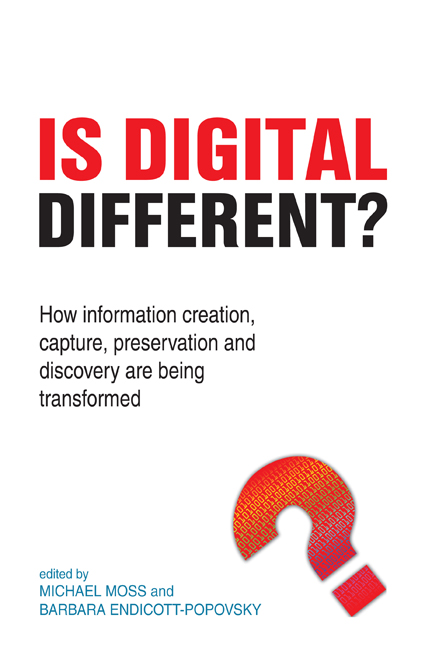 Is Digital Different?
Is Digital Different? Book contents
- Frontmatter
- Contents
- Contributors
- Introduction and acknowledgements
- 1 What is the same and what is different
- 2 Finding stuff
- 3 RDF, the Semantic Web, Jordan, Jordan and Jordan
- 4 Crowdsourcing
- 5 Pathways to integrating technical, legal and economic considerations in the design, development and deployment of trusted IM systems
- 6 Finding archived records in a digital age
- 7 Security: managing online risk
- 8 Rights and the commons: navigating the boundary between public and private knowledge spaces
- 9 From the Library of Alexandria to the Google Campus: has the digital changed the way we do research?
- Index
7 - Security: managing online risk
Published online by Cambridge University Press: 08 June 2018
- Frontmatter
- Contents
- Contributors
- Introduction and acknowledgements
- 1 What is the same and what is different
- 2 Finding stuff
- 3 RDF, the Semantic Web, Jordan, Jordan and Jordan
- 4 Crowdsourcing
- 5 Pathways to integrating technical, legal and economic considerations in the design, development and deployment of trusted IM systems
- 6 Finding archived records in a digital age
- 7 Security: managing online risk
- 8 Rights and the commons: navigating the boundary between public and private knowledge spaces
- 9 From the Library of Alexandria to the Google Campus: has the digital changed the way we do research?
- Index
Summary
At least weekly we hear about significant data breaches or cyber attacks that threaten the financial health and privacy of millions of online users, or describe attacks by nation-states or terrorist groups with a political or propagandistic agenda. To the citizen observer, it must appear that those responsible for managing networks are helpless to do anything about rising online crime and threats.
How did we get here? How did our online interconnectedness, which has created so many benefits, result in so many challenges? Have we been so enamoured of creating the next new digital device or online service that we didn't take time to consider the unintended consequences that we've introduced into our lives (Endicott-Popovsky, 2008)?
Drawing on the field of cognitive psychology for an answer, I would suggest that we have outdated mental models that have blinded our perceptions. Drawing on systems dynamics, I suggest that we have relied too heavily on linear thinking and lack the skills in systems thinking to have foreseen this or to think through effective solutions to resolve the online crisis we're in. Drawing on theories of criminal justice, I suggest that we have not incorporated deterrence into the development of online systems; as a result, our systems unintendedly encourage bad behaviour – something like leaving our back doors unlocked and our wallets sitting in full view on the kitchen table! Each of these explanations will be examined in this chapter, ending with an admonition about how we should think of ourselves and our activities online in order to stay reasonably safe.
Drawing on mental models
The mental-model theory of reasoning was developed by Princeton University psychologist Philip Johnson-Laird (Johnson-Laird, 1983) and further enhanced by Ruth M. J. Byrne (Byrne, 2005). A mental model describes how an individual perceives that reality and functions in the world by thinking through conceptual representations of external reality. The Scottish philosopher Kenneth Craik suggests that the human mind constructs these models in order to anticipate and predict events so that we humans can function effectively in the real world (Craik, 1943). An individual will rely on these models to solve problems, assess the potential consequences of those solutions and gauge their actions accordingly. It becomes a personal algorithm for living.
- Type
- Chapter
- Information
- Is Digital Different?How information creation, capture, preservation and discovery are being transformed, pp. 149 - 170Publisher: FacetPrint publication year: 2015


